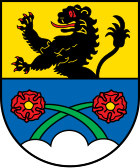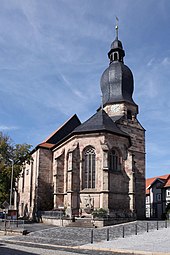Schalkau
| coat of arms | Germany map | |
|---|---|---|

|
Coordinates: 50 ° 24 ' N , 11 ° 1' E |
|
| Basic data | ||
| State : | Thuringia | |
| County : | Sonneberg | |
| Height : | 400 m above sea level NHN | |
| Area : | 44.03 km 2 | |
| Residents: | 3318 (Dec. 31, 2019) | |
| Population density : | 75 inhabitants per km 2 | |
| Postal code : | 96528 | |
| Area code : | 036766 | |
| License plate : | SON, NH | |
| Community key : | 16 0 72 015 | |
| LOCODE : | DE SKU | |
| City structure: | 10 districts | |
City administration address : |
Markt 1 96528 Schalkau |
|
| Website : | ||
| Mayoress : | Ute Hopf (independent) | |
| Location of the city of Schalkau in the district of Sonneberg | ||
Schalkau is a town in the district of Sonneberg in the Franconian part of Thuringia .
geography
The city is located on the southern slope of the Thuringian Slate Mountains in the valley of the Upper Itz on the Schalkau Plateau . The 867 meter high Bleßberg is six kilometers north of the city .
Neighboring communities
Clockwise, starting in the north: Neuhaus am Rennweg , Frankenblick , Rödental , Lautertal , Eisfeld .
City structure
The city has ten districts:
|
|
history
Until the 19th century
Not far from the district of Theuern is a former fortification on a narrow ridge of the Herrenberg at the exit of the Grümpen river from the mountains of the Thuringian Forest. With it, the ancestors controlled and monitored the traffic connection in the Eisfeld settlement area from the Orlatal and from northern Germany. The square was used in the pre-Roman Iron Age . The walls are still well preserved.
The place Schalkau is first mentioned in 1011. In 1362 he was granted town and market rights. In the Middle Ages, the history of the settlement was largely determined by the noble family of the Schaumbergs , who had their ancestral seat at the nearby Schaumberg Castle . The castle was built in the 12th century and destroyed during the Thirty Years War .
From 1830 onwards, several small toy factories were established and Schalkau developed into a local center of the toy industry, for which there was a technical school for drawing, modeling and wood carving between 1881 and 1935.
20th century
The city belonged to the Duchy of Saxony-Meiningen, which became a Free State on November 12, 1918 and was incorporated into the newly created state of Thuringia on May 1, 1920.
During the time of National Socialism , Schalkau residents were persecuted for political and religious reasons and imprisoned in the Schalkau court prison or, like a Jehovah's Witness , deported to the Mauthausen concentration camp . Since 1934, 200 Protestant residents of the Confessing Church (BK) have joined the site, which was led by the pastors Raatz and Graser. Both lost their pastoral office in the Thuringian Church in 1935 .
As part of the promotion of the armaments industry in Thuringia, the Bruhn-Werke GmbH Berlin-Schöneberg plant was built in Schalkau in 1938, in which aeronautical instruments such as airspeed indicators for the Air Force were initially manufactured by around 800 people. After the Second World War, the machine park was dismantled and the buildings were blown up in August 1947.
During the Second World War , more than 220 prisoners of war from France as well as women and men from Poland, Russia and the Ukraine had to do forced labor : in Bruhn-Werken GmbH and at the AH Schwesinger company . Three of the forced laborers were sentenced to prison.
During the GDR era, the GDR television network ran a company holiday camp for the children of its employees.
In the 1970s, the Görsdorf district was enclosed by the GDR with an approximately 3.5 meter high screen (border wall). The Görsdorf border monument commemorates the division of Germany .
Before May 31, 1995, Schalkau was part of the administrative community of Schalkau .
Incorporations
The following municipalities (with the districts mentioned above) were incorporated into the city:
- on July 1, 1950 Ehnes ,
- on January 1, 1992 Roth and Theuern ,
- on June 1, 1992 Mausendorf and Truckenthal ,
- on July 14, 1993 Katzberg ,
- on February 8, 1994 Ehnes and Emstadt ,
- on July 1, 1994 Almerswind ,
- on December 31, 2019 Bachfeld .
Population development
Development of the population (as of December 31st) :
|
|
|
|
- Data source from 1994: Thuringian State Office for Statistics
politics
turnout: 64.9% (2014: 55.5%)
City council
The city council in Schalkau consists of 16 council members:
| Political party | Seats |
|---|---|
| CDU | 6 (−2) |
| AfD | 3 (+3) |
| Free voters | 3 (+1) |
| THE LEFT | 2 (−2) |
| Forum active citizens | 2 (± 0) |
In the 2019 election, 14 city council members were initially elected in Schalkau, 2 fewer than in 2014 . In the course of the integration of Bachfeld at the end of 2019, 2 members of his municipal council came to the Schalkau council (1 × CDU, 1 × free voters).
(As of: local election on May 26, 2019 )
mayor
In the election of the mayor on April 15, 2018 , Ute Hopf, a non-party candidate, was elected mayor with 56.6% of the vote. The turnout was 68.3%.
Town twinning
A partnership with the Franconian neighboring town of Rödental has existed since 1990 ,
On September 13, 2018, the long-term partnership with the Franconian neighboring community of Lautertal was officially sealed.
coat of arms
| Blazon : "The city coat of arms shows a shield divided from gold over blue, at the top a growing red-armored black lion, at the bottom two green-booted red roses with gold clusters growing out of silver three-mountain." | |
Culture and sights
societies
In the city of Schalkau, which consists of nine districts, there are 36 associations with around 1,200 members.
education and parenting
The state community school "Johann Wolfgang von Goethe" Schalkau belongs to the city of Schalkau. The school is attended by approx. 550 pupils , including the parts of the school in Rauenstein and Mengersgereuth-Hammern .
The whirlwind integrative day care center looks after around 130 children between the ages of one and six. This also includes children with developmental retardation, disabled children or children at risk of disability.
Tourism and sightseeing
The ruins of the medieval Schaumburg can be found near the town of Schalkau. The history of this castle complex and the development of the city are dealt with in detail in the Schalkau local history museum .
The city of Schalkau is part of the Schaumberger Land tourism association. This also includes the community of Frankenblick in the district of Sonneberg. With the entry of Rödental, the catchment area of the tourism association expands to include Upper Franconia. Rödental has been working together with Schalkau in terms of tourism for years.
The Way of St. James runs through Schalkau.
Economy and Infrastructure
traffic
The Eisfeld – Sonneberg railway , a single-track branch line from Eisfeld via Schalkau to Sonneberg , runs through the village . All districts are on the line network of the Omnibus Verkehrs Gesellschaft Sonneberg / Thür. connected, which ensures connections to the district town of Sonneberg and the cities of Rödental, Coburg and Eisfeld. In addition, the B 89 runs through Schalkau. Other roads lead from Schalkau to Rödental and Steinheid .
Public safety, fire safety and health
In Schalkau there is one of five base fire brigades in the Sonneberg district and an ambulance station belonging to the Regiomed-Kliniken Group is in the immediate vicinity .
Personalities
- Jan Eichhorn (* 1981), luge rider from Ehnes
- Michael Erich Franck (1691–1721), novelist
- Julius Hoffmann (1810–1882), member of the Frankfurt National Assembly and Lord Mayor of Eisfeld
- Michael Heinrich Krause (1651–1729), Protestant theologian and first superintendent of Schalkaus.
- Maximilian Mörlin (1516–1584), Protestant theologian and reformer
- David Möller (* 1982), two-time luge world champion from Truckenthal
- Fritz Müller (1907–2001), space engineer
- Johann Georg Otto (1744–1829), bailiff in Schalkau and Privy Councilor
- Gerhard Rommel (1934–2014), sculptor, medalist, coin designer and painter
- Gerwalt Zinner (1924–2011), chemist, chemistry professor
- Johann Gabriel Doppelmayr (1677-1750), German astronomer , doctor in Schalkau
literature
- City of Schalkau (Ed.): Schalkau - the city and its citizens. Festschrift 1362–2012. City of Schalkau, Schalkau 2012.
Individual evidence
- ^ Population of the municipalities from the Thuringian State Office for Statistics ( help on this ).
- ↑ Michael Köhler: Thuringian castles and fortified prehistoric and early historical living spaces. Jenzig-Verlag Köhler, Jena 2001, ISBN 3-910141-43-9 , p. 138.
- ↑ Thuringian Association of the Persecuted of the Nazi Regime - Association of Antifascists and Study Group of German Resistance 1933–1945 (Ed.): Local history guide to sites of resistance and persecution 1933–1945. Volume 8: Thuringia. VAS - Verlag für Akademische Schriften, Frankfurt am Main 2003, ISBN 3-88864-343-0 , p. 287.
- ↑ a b Local council election Schalkau 2014 - election results
- ↑ a b Local council election Schalkau 2019 - election results
- ↑ Cindy Heinkel: Selters instead of sparkling wine meet the mood of the Bach fields . In: Free Word Local Edition Sonneberg of December 31, 2019, p. 7 ( online )
- ^ Main statutes of the city of Schalkau. Retrieved October 14, 2019 .
- ↑ At a glance - Thuringian school portal. Retrieved on March 16, 2018 (German).
- ↑ Schalkau * - Diakoniewerk Sonneberg. (No longer available online.) Archived from the original on March 17, 2018 ; accessed on March 16, 2018 (German). Info: The archive link was inserted automatically and has not yet been checked. Please check the original and archive link according to the instructions and then remove this notice.
- ^ Radio Eins (Coburg): News. (No longer available online.) Archived from the original on May 13, 2012 ; accessed on June 1, 2017 . Info: The archive link was inserted automatically and has not yet been checked. Please check the original and archive link according to the instructions and then remove this notice.
- ↑ www.jakobus-franken.de
- ^ German Museum Munich (Digiporta): Doppelmayr, Johann Gabriel. In: Digital portrait archive (Digiporta). Deutsches Museum München, accessed on October 22, 2019 .






